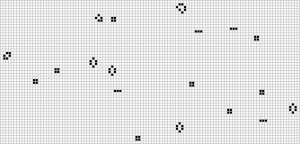R-pentomino
The R-pentomino is a methuselah that was found by John Conway in 1969.[1] It is by far the most active polyomino with fewer than six cells; all of the others stabilize in at most 10 generations, but the R-pentomino does not do so until generation 1103, by which time it has a population of 116. The glider it releases in generation 69, noticed by Richard K. Guy, was the first glider ever observed.
| R-pentomino | |||
| |||
| View static image | |||
| Pattern type | Methuselah | ||
|---|---|---|---|
| Number of cells | 5 | ||
| Bounding box | 3×3 | ||
| MCPS | 5 | ||
| Lifespan | 1103 generations | ||
| Final population | 116 | ||
| L/I | 220.6 | ||
| F/I | 23.2 | ||
| F/L | 0.105 | ||
| L/MCPS | 220.6 | ||
| Discovered by | John Conway | ||
| Year of discovery | 1969 | ||
| |||
| |||
Predecessors
The R-pentomino has several different small predecessors which are of note because they naturally have a longer lifespan. There are three 5-cell grandparents of the R-pentomino (which each have a lifespan of 1105 generations) and three 6-cell predecessors that evolve into the R-pentomino after 5 generations (and thus have a total lifespan of 1108).
The three 5-cell grandparents of the R-pentomino. |
Three 6-cell predecessors that each evolve into the R-pentomino at generation 5. |
Evolution
The R-pentomino initially grows in all directions. A c/2 forward growth mechanism emerges at generation 7, and by generation 27 finally separates. From here on this part of the pattern proceeds along the B-heptomino evolution.
The left-behind chaos is whittled down by generation 40 into two halves, one of which would produce a traffic light and the other a honey farm, if left on their own. These however react with each other to produce a large cloud of further growth, and by generation 104 this consumes the block left behind by the B-heptomino. The third glider also escapes around this time, followed by a fourth at generation 156.
The Herschel from the initial B finishes by generation 176, having created a ship, two blocks and two gliders as usual. By generation 198, a small active intrusion close to these creates two beehives (one of which will be later destroyed) and the fifth escaping glider.
The next surviving objects to be created are a boat formed at generation 599, a block formed at generation 646 and a glider released at generation 699 (though several temporary blocks, blinkers, boats, beehives, traffic lights and two temporary gliders have been seen by this point).
A toad forms at generation 737 and a beacon at generation 744, but both are destroyed by the activity at generations 751 and 754 respectively.
Besides revealing the first glider, the R revealed how to make the first gun, but this was ignored at the time. A queen bee lives from 774 thru 791. The MIT AILab group glimpsed it, but uncertainty at what they saw and their clumsy software postponed the discovery of the queen bee shuttle and glider gun.
The pi heptomino sequence pops in for a cameo at several points, the longest-surviving instance running between generations 784 and 803. The century sequence also makes a brief appearence, between generations 316 and 333.
The stable pattern that results from the R-pentomino has 116 cells and consists of eight blocks, six gliders, four beehives, four blinkers, one boat, one loaf, and one ship.
 Generation 1103 (excluding six gliders). |
See also
References
- Gardner, M. (1983). "The Game of Life, Part III". Wheels, Life and Other Mathematical Amusements: 219, 223, W.H. Freeman.
